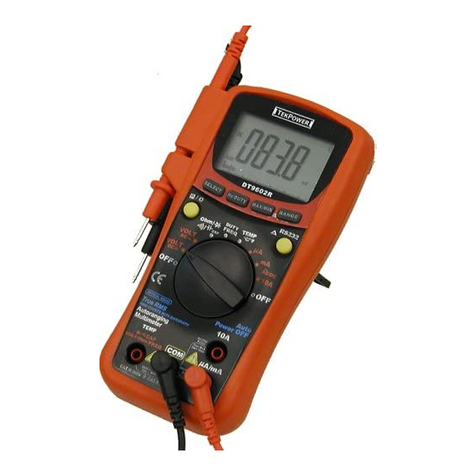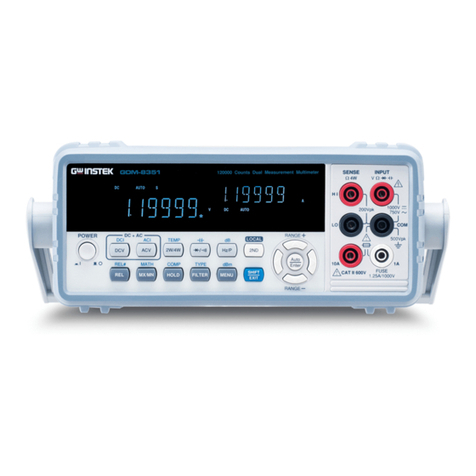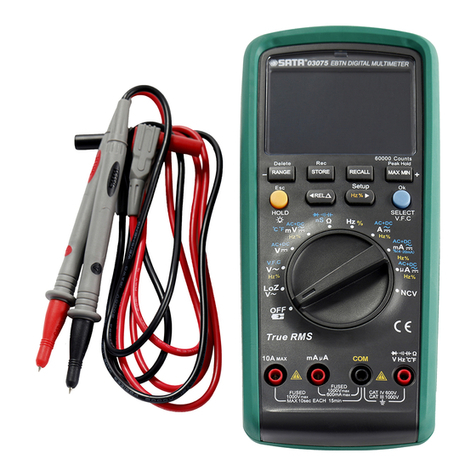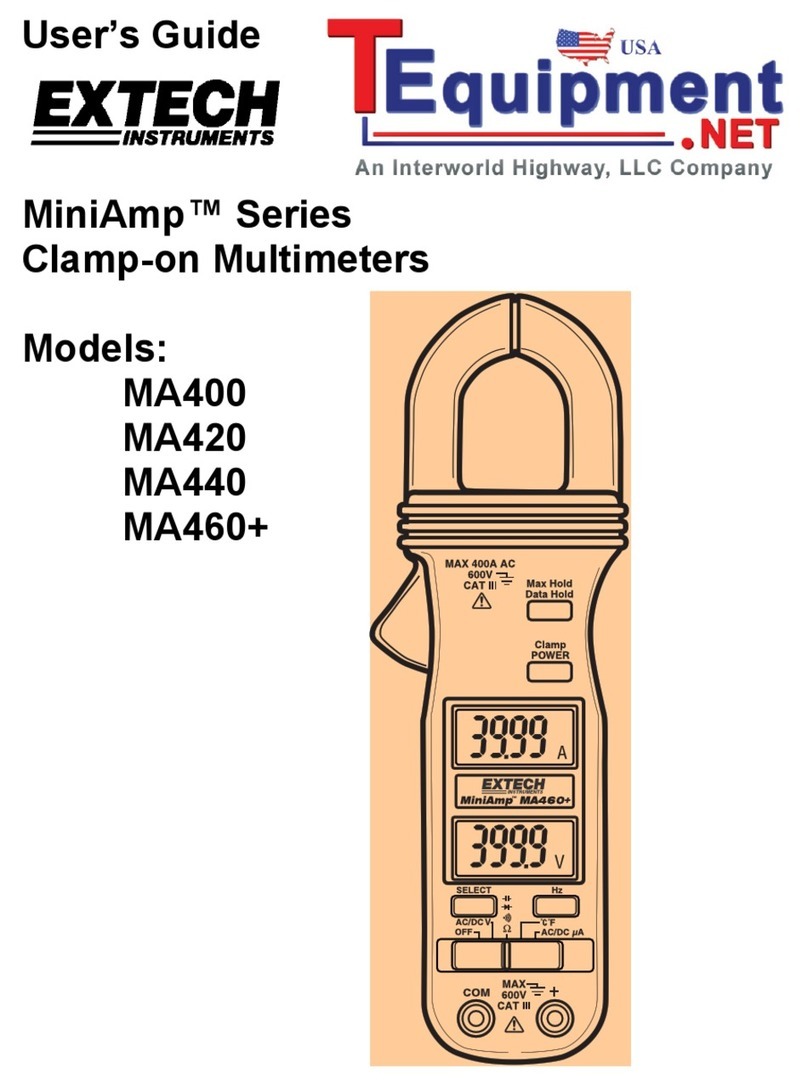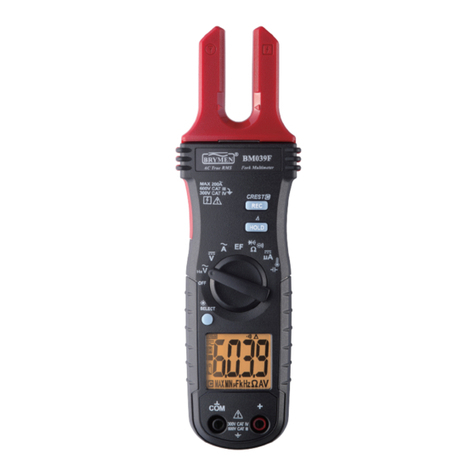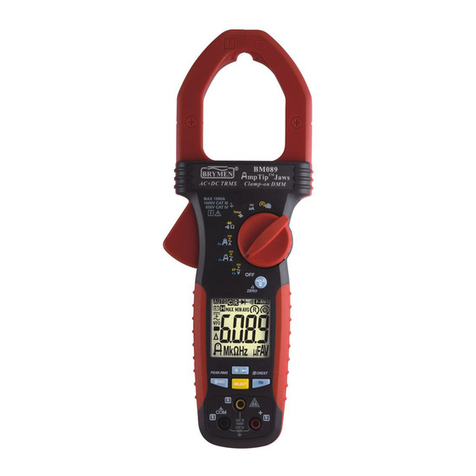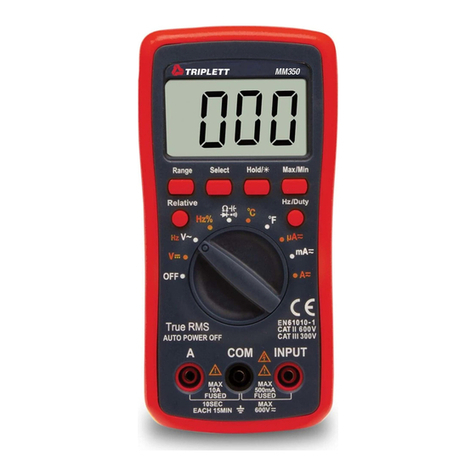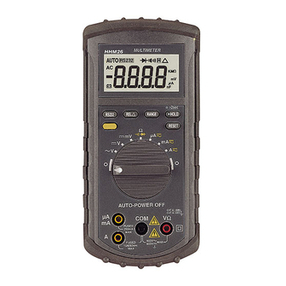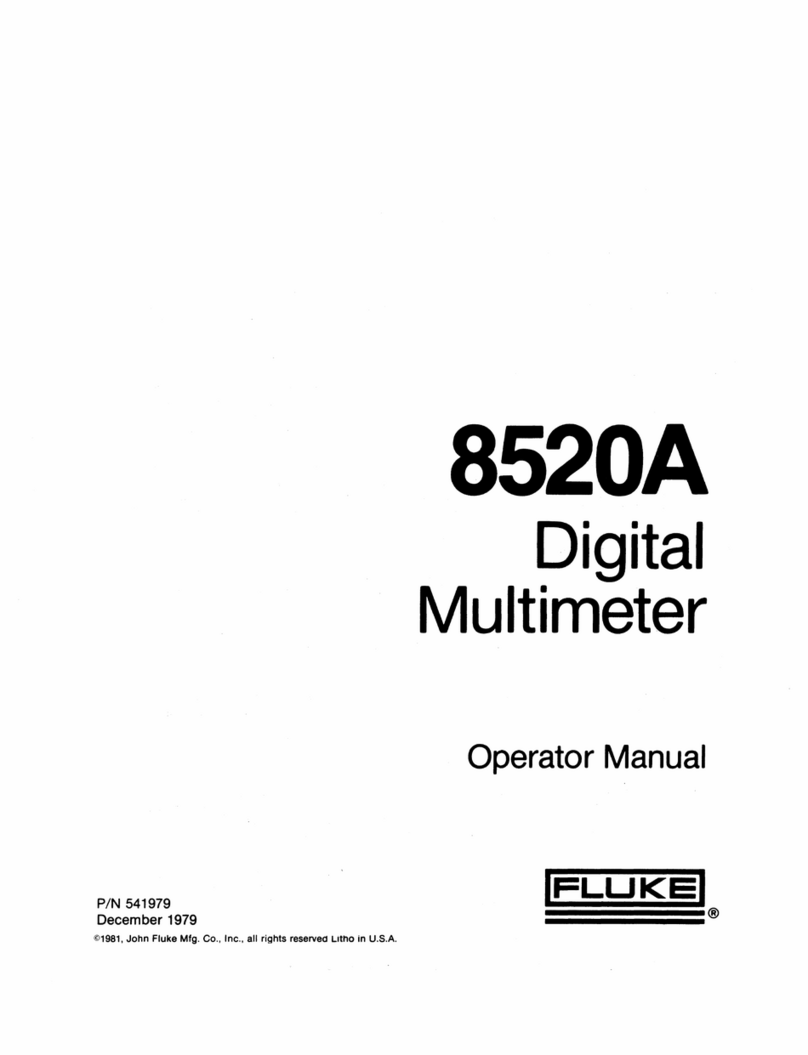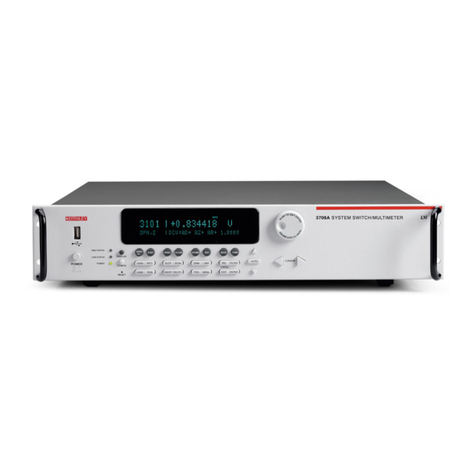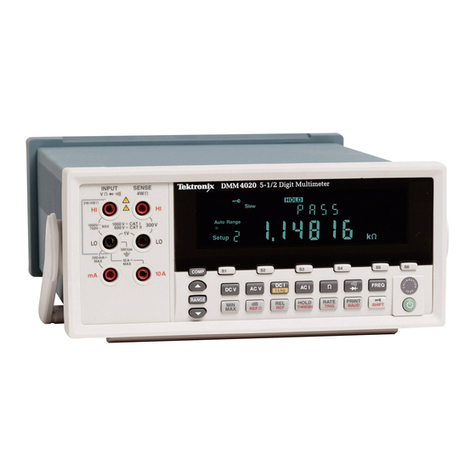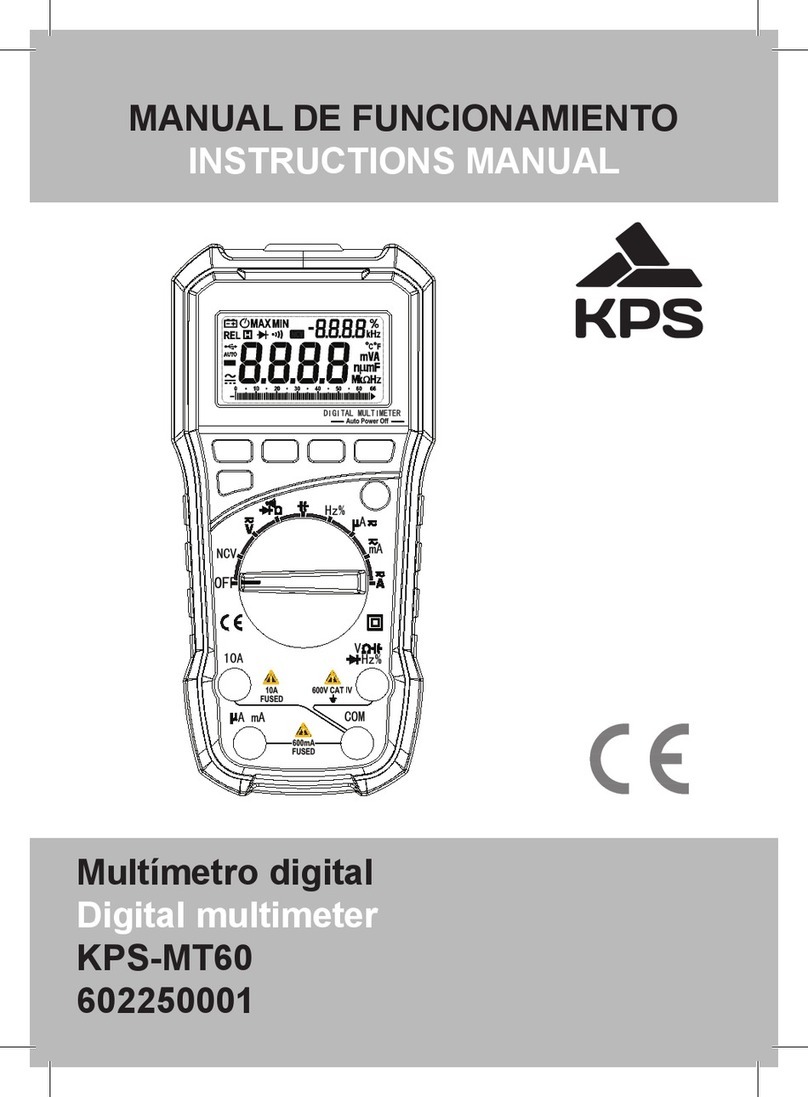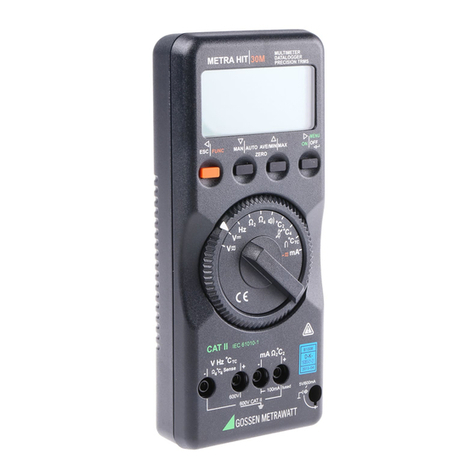TekPower TP40 User manual

Contents
TITLE
PAGE
1. GENERAL INSTRUCTIONS
……………..
1
1.1 Precaution safety measures
……………..
1
1.1.1 Preliminary
……………..
1
1.1.2 During use
……………..
4
1.2 Symbols
……………..
6
1.3 Instructions
……………..
7
2. DESCRIPTION
……………..
8
2.1 Instrument Familiarization
……………..
8
2.2 LCD Display
……………..
10
2.3 Key pad
……………..
11
3. FUNCTION DESCRIPTION
……………..
13
3.1 General Functions
……………..
13
3.1.1 DATA HOLD mode
……………..
13
3.1.2 Manual ranging and
Autorange mode
……………..
14
3.1.3 Battery saver
……………..
15
3.1.4 Relative measurement mode
…………….
15

TITLE
PAGE
3.1.5 True RMS measurement
……………..
15
3.2 Measurement Functions
……………..
16
3.2.1 AC and DC Voltage measurement
……………..
16
3.2.2 Resistance measurement
……………..
19
3.2.3 Capacitance measurement
……………..
21
3.2.4 Continuity Check
……………..
23
3.2.5 Diode Test
……………..
26
3.2.6 Frequency measurement
……………..
29
3.2.7 Temperature measurement
……………..
30
3.2.8 Current measurement
……………..
31
3.2.9 NCVhEF
……………..
33
3.2.10 PC Link
……………..
34
4. TECHNICAL SPECIFICATIONS
……………..
35
4.1 General specifications..
……………..
35
4.2 Measurement specifications
………….….
36
4.2.1 Voltage
……………..
37
4.2.2 Frequency
……………..
38
4.2.3 Resistance
……………..
39
4.2.4 Diode Test
……………..
39

TITLE
PAGE
4.2.5 Continuity Check
……………..
39
4.2.6 Capacitance
……………..
40
4.2.7 Temperature
……………..
40
4.2.8 Current
……………..
40
5. MAINTENANCE
……………..
41
5.1 General maintenance
……………..
42
5.2 Fuse replacement
……………..
42
5.3 Battery replacement
……………..
43
6. ACCESSORIES
……………..
44

1. GENERAL INSTRUCTIONS
This instrument complies with IEC 61010-1: 2001, CAT Ⅲ
1000V and CAT Ⅵ600V overvoltage standards. See
Specifications.
To get the best service from this instrument, read carefully
this user's manual and respect the detailed safety
precautions.
International symbols used on the Meter and in this manual
are explained in chapter 1.2.
1.1 Precautions safety measures
1.1.1 Preliminary
* As the possibilities of high transient overvoltages occurred
in today’s power systems increase, more stringent safety
standards are set for the electrical test equipment. Transients
on electrical systems(power grid, feeder or branch circuits)
will trigger a series of incidents that may result in serious
personal injury. To protect you against transients, safty must
be built into the test equipment.
Overvoltage
category
In brief
Examples
CATⅠ
Electronic
• Protected electronic
equipment.
• Equipment connected to
(source) circuits in which
measures are taken to
limit transient

overvoltages to an
appropriately low level.
• Any high-voltage,
low-energy source
derived from a
highwinding resistance
transformer, such as the
high-voltage section of a
copier.
CATⅡ
Single-phase
receptacle
connected
loads
• Appliance, portable tools,
and other household and
similar loads.
• Outlet and long branch
circuits.
• Outlets at more than 10
meters (30 feet) from CAT
III source.
• Outlets at more that 20
meters (60 feet) from CAT
IV source.
CAT Ⅲ
Three-phase
distribution,
including
single-phase
commercial
lighting
• Equipment in fixed
installations, such as
switchgear and polyphase
motors.
• Bus and feeder in
industrial plants.

• Feeders and short
branch circuits, distribution
panel devices.
• Lighting systems in larger
buildings.
• Appliance outlets with
short connections to
service entrance.
CAT Ⅵ
Three-phase
at utility
connection,
any outdoor
conductors
• Refers to the “origin of
installation”; i.e., where
low-voltage connection
is made to utility power.
• Electricity meters,
primary overcurrent
protection equipment.
• Outside and service
entrance, service drop
from pole to building, run
between meter and
panel.
• Overhead line to
detached building,
underground line to well
pump.
* When using this Multimeter, the user must observe all
normal safety rules concerning:

― protection against the dangers of electric current.
― protection of the Multimeter against misuse.
* For your own safety, only use the test probes supplied with
the instrument. Before use, check that they are in good
condition.
1.1.2 During use
* If the meter is used near noise generating equipment, be
aware that display may become unstable or indicate large
errors.
* Do not use the meter or test leads if they look damaged.
* Use the meter only as specified in this manual; otherwise,
the protection provided by the meter may be impaired.
* Use extreme caution when working around bare
conductors or bus bars.
* Do not operate the meter around explosive gas, vapor, or
dust.
* Verify a Meter's operation by measuring a known voltage.
Do not use the Meter if it operates abnormally. Protection
may be impaired. When in doubt, have the Meter serviced.
* Uses the proper terminals, function, and range for your
measurements.
* When the range of the value to be measured is unknown,
check that the range initially set on the multimeter is the
highest possible or, wherever possible, choose the
autoranging mode.
* To avoid damages to the instrument, do not exceed the
maximum limits of the input values shown in the technical

specification tables.
* When the multimeter is linked to measurement circuits, do
not touch unused terminals.
* Caution when working with voltages above 60Vdc or 30Vac
rms. Such voltages pose a shock hazard.
* When using the probes, keep your fingers behind the finger
guards.
* When making connections, connect the common test lead
before connecting the live test lead; when disconnecting,
disconnect the live test lead before disconnecting the
common test lead.
* Before changing functions, disconnect the test leads from
the circuit under test.
* For all dc functions, including manual or auto-ranging, to
avoid the risk of shock due to possible improper reading,
verify the presence of any ac voltages by first using the ac
function. Then select a dc voltage range equal to or
greater than the ac range.
* Disconnect circuits power and discharge all high-voltage
capacitors before testing resistance, continuity, diodes, or
capacitance.
* Never perform resistance or continuity measurements on
live circuits.
* Before measuring current, check the meter's fuse and turn
off power to the circuit before connecting the meter to
the circuit.
* In TV repair work, or when carrying out measurements on

power switching circuits, remember that high amplitude
voltage pulses at the test points can damage the
multimeter. Use of a TV filter will attenuate any such
pulses.
* Use just one 6F22 battery, properly installed in the Meter's
battery case, to power the Meter.
* Replace the battery as soon as the battery indicator
( ) appears. With a low battery, the Meter might
produce false readings that can lead to electric shock and
personal injury.
* Do not measure voltages above 1000V in Category III, or
600V in Category Ⅳinstallations.
* When in REL mode, the “REL” symbol is displayed.
Caution must be used because hazardous voltage may be
present.
* Do not operate the Meter with the case (or part of the case)
removed.
1.2 Symbols:
Symbols used in this manual and on the instrument:
Caution:refer to the instruction manual.
Incorrect use may result in damage to the device
or its components.
~
AC (Alternating Current)
DC (Direct Current)
AC or DC

Earth ground
Double insulated
Fuse
Conforms to European Union directives
1.3 Instructions
* Remove test leads from the Meter before opening the
Meter case or battery cover.
* When servicing the Meter, use only specified replacement
parts.
* Before opening up the instrument, always disconnect from
all sources of electric current and make sure you are not
charged with static electricity, which may destroy internal
components.
* Any adjustment, maintenance or repair work carried out on
the meter while it is live should be carried out only by
appropriately qualified personnel, after having taken into
account the instructions in this present manual.
* A "qualified person" is someone who is familiar with the
installation, construction and operation of the equipment
and the hazards involved. He is trained and authorized to
energize and de-energize circuits and equipment in
accordance with established practices.
* When the instrument is opened up, remember that some
internal capacitors can retain a dangerous potential even

after the instrument is switched off.
* If any faults or abnormalities are observed, take the
instrument out of service and ensurethat it cannot be used
until it has been checked out.
* If the meter is not going to be used for a long time, take out
the battery and do not store the meter in high temperature
or high humidity environment.
2. DESCRIPTION
2.1 Instrument Familiarization
The front panel is shown as in Figure 2-1,
explanation being as follows:
①LCD display
Used for displaying the measuring results and various
symbols.
②Keypad
Measurement function keys.
③Rotary switch
Used for selecting measurement functions.
④
VHz
Terminal receiving the red test lead for voltage,
resistance, capacitance, frequency, Temperature,
diode and continuity measurements.
⑤uA/mA
Terminal receiving the red test lead for A, mA

measurements.
⑥A Terminal receiving the red test lead for 6A,10A
measurements.
⑦COM
Terminal receiving the black test lead as a common
reference.
A
mA
uA
C
。
Hz
mV
V
V
OFF
F
。
COM
A
VHz
CAT III 1000V
CAT IV 600V
600mA MAX
mA
uA
FUSED
10A MAX
3
2
1
4
7
6
5
Figure 2-1

2.2 LCD Display
12
11
10
9
3
2
1
4
7
6
58
15
13
14
Figure 2-2
LCD screen is shown as in Figure 2-2, with its every symbol’s
meaning shown as in the Table 1:
No.
Symbol
Meaning
1
Indicates negative readings
2
Indicator for AC voltage or
current
3
Indicator for DC voltage or
current

4
AUTO
The meter is in the Autorange
mode in which the meter
automatically selects the range
with the best resolution.
5
PC-LINK
The Meter is in the data
transmission mode.
6
NCV
No contact AC Voltage detect
7
H
The meter is in Data Hold
mode.
8
REL
The meter is in Relative
Measurement mode.
9
MAX
Display maximum data
10
MIN
Display minimum data
11
Low battery indication
12
The meter is in Continuity
Check mode.
13
The meter is in Diode Test
mode.
14
%℃℉ KMHz
nμmFAV
Measurement units
15
This symbol means that the
input is too large for the
selected range.
2.3 Keypad
2.3.1 SELECT

Changeto the second function.
1. At and position
Switches between Resistance measurement, Diode
Test and Continuity check.
2. At A mA Aposition
Switches between dc and ac current.
3. Power-up Option
Disables automatic power-off feature. Keep press
this key when power on.
2.3.2
Press it to enter and exit the Data Hold mode. Press it
and hold 2 seconds, backlight on; if pressit and hold for
2 seconds again, backlight off.
2.3.3 RANGE
At V~, V , , A, mA and A.
1. Press RANGE to enter the manual ranging mode.
2. Press RANGE to step through the ranges available
for the selected function.
3. Press and hold RANGE for 2 seconds to return to
autoranging.
2.3.4 REL△
1.Press REL△to enter and exit the Relative
measurement mode. (Except Hz/Duty)
2. Keep press REL△more than 2 seconds to enter the
the PCLINK mode.

2.3.5 Hz %
At V~, A, mAand A.
1. Press it to start the frequency counter.
2. Press it again to enter duty (load factor) mode.
3. Press it again to exit the frequency counter mode.
2.3.6 MAX/MIN
This key is for measuring maximum value and minimum
value.
1. Press it to enter Max/Min mode.
2. Press it again; the LCD will display the Maximum
Value.
3. Press it again; the LCD will display the Minimum
Value.
4. Press and hold it for two seconds, the meter will
return to normal measurement state.
(Except Hz/Duty and Capacitance)
3. FUNCTION DESCRIPTION
3.1 General Functions
3.1.1 DATA HOLD mode
Data Hold mode makes the meter stop updating the display.
Enabling Data Hold function in autorange mode makes the
meter switch to Manual ranging mode, but the full-scale
range remains the same. Data Hold function can be
cancelled by changing the measurement mode, pressing
RANGE key, or push key again.

To enter and exit the Data Hold mode:
1. Press key (short press). Fixes the display on the
current value, His displayed.
2. A second short press returns the meter to normal mode.
3.1.2 Manual ranging and Autorange mode
The Meter has both manual ranging and autorange options.
* In the autorangemode, the Meter selects the best range for
the input detected. This allows you to switch test points
without having to reset the range.
* In the manual ranging mode, you select the range. This
allows you to override autorange and lock the meter in a
specific range.
* The Meter defaults to the autorange mode in measurement
functions that have more than one range. When the Meter is
in the autorange mode, AUTO is displayed.
To enter and exit the manual range mode:
1. Press RANGE key. The Meter enters the manual ranging
mode. AUTO turns off. Each presses of RANGE key
increments the range. When the highest range is reached,
the Meter wraps to the lowest range.
NOTE: If you manually change the measurement range after
entering the Data Hold modes, the Meter exits this mode.
2. To exit the manual ranging mode, press and hold down
RANGE key for two seconds. The Meter returns to the
autorange mode and AUTO is displayed.

3.1.3 Battery Saver
The Meter enters the "sleep mode" and blanks the display if
the Meter is on but not used for 15 minutes.
Press the key or rotate the rotary switch to wake
the meter up.
To disable the Sleep mode, hold down the SELECT key
while turning the meter on.
3.1.4 Relative measurement mode
The Meter will display relative measurement in all functions
except frequency.
To enter and exit the relative measurement mode:
1. With the Meter in the desired function, touch the test leads
to the circuit on which you want future measurement to be
based.
2. Press REL△key to store the measured value and
activate the relative measurement mode. The difference
between the reference value and subsequent reading is
displayed.
3. Press REL△key again return the Meter to normal
operation.
3.1.5 TRUE RMS measurement
All the AC measurement values is the true RMS (true

root-mean-square) values.
Frequency range is up to 1KHz.
3.2 Measurement Functions
3.2.1 AC and DC Voltage measurement
To avoid electrical shock and/or damage to the
instrument, do not attempt to take any voltage
measurement that might exceeds 1000Vdc or
1000Vac rms.
To avoid electrical shock and/or damage to the
instrument, do not apply more than 1000Vdc or
1000Vac rms between the common terminal and
the earth ground.
The Meter's voltage ranges are 600.0mV, 6.000V, 60.00V,
600.0V and 1000V.
To measure ac or dc voltage (set up and connect the Meter
as shown in Figure 3-1):
1. Set rotary switch to the DCV, ACV or AC/DCmV
range.
2. Connect the black and red test leads to the COM and
V terminals respectively.
3. Connect the test leads to the circuit being measured
4. Read the displayed value. The polarity of red test lead
connection will be indicated when making a DCV
measurement.
NOTE:
Unstable display may occur especially at 600mV range,

even though you do not put test leads into input terminals
For better accuracy when measuring the dc offset of an ac
voltage, measure the ac voltage first. Note the ac voltage
range, then manually select a dc voltage range equal to or
higher than the ac range. This improves the accuracy of the
dc measurement by ensuring that the input protection circuits
are not activated.
A
mA
uA
C
。
Hz
mV
V
V
OFF
F
。
COM
A
VHz
mA
uA
V
V
AC Voltage
Table of contents
Other TekPower Multimeter manuals
